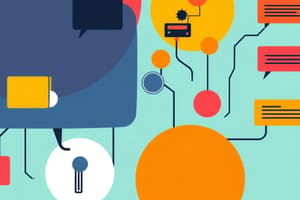Podcast
Questions and Answers
Which model of communication represents a one-way process where feedback is not required?
Which model of communication represents a one-way process where feedback is not required?
- Schramm Model
- Interactive Model
- Transactional Model
- Shannon-Weaver Model (correct)
In which model do the sender and receiver share equal roles in the communication process?
In which model do the sender and receiver share equal roles in the communication process?
- Shannon-Weaver Model
- Transactional Model
- Linear Model
- Interactive Model (correct)
What element was added by Schramm to the Shannon-Weaver Model?
What element was added by Schramm to the Shannon-Weaver Model?
- Encoding
- Decoding
- Feedback (correct)
- Noise
Which of the following is an example of a communication activity in the linear model?
Which of the following is an example of a communication activity in the linear model?
The transactional model of communication is characterized by which of the following?
The transactional model of communication is characterized by which of the following?
What is the primary function of noise in the communication models discussed?
What is the primary function of noise in the communication models discussed?
Which communication model includes the process of encoding and decoding as integral components?
Which communication model includes the process of encoding and decoding as integral components?
What role does feedback play in the interactive communication model?
What role does feedback play in the interactive communication model?
In the context of communication models, what is the main difference between the interactive and transactional models?
In the context of communication models, what is the main difference between the interactive and transactional models?
Which of the following best describes the sender's role in the linear communication model?
Which of the following best describes the sender's role in the linear communication model?
Flashcards are hidden until you start studying
Study Notes
Communication Participants
- Participants include senders and receivers who can exchange messages simultaneously.
- Noise refers to distractions that disrupt message interpretation and can create barriers in communication.
- Effective communication may require clarifying intended meanings when messages are not clearly conveyed.
Helical Model
- Distinguishes itself with an upward and forward movement of knowledge through interaction.
- Communication evolves from birth, influenced by past experiences that shape present responses.
- Emphasizes the journey of learning, exemplified by acquiring new vocabulary.
Elements of Communication
- Participants: Communicators who act as senders (transmitters of information) and receivers (decoders of messages).
- Context: Interrelated conditions affecting communication, including:
- Physical context: Time, environment, and distance.
- Social context: Relationships between communicators.
- Psychological context: Moods and feelings.
- Cultural context: Beliefs and norms of participants.
- Message: The core idea or information conveyed by the sender.
Verbal Communication
- Involves the use of speech to express thoughts and ideas.
- Common forms include telephone conversations, job interviews, speeches, classroom teaching, and casual conversations.
Nonverbal Communication
- Utilizes wordless cues like facial expressions, body language, and vocal tones to convey messages.
- Examples include gestures like shaking your head, smiling, or displaying a blank stare.
Process of Communication
- Begins with a stimulus activated by the sender who encodes the message into words.
- The receiver decodes and interprets the message, providing feedback that may trigger a new communication cycle.
- Role exchanges between sender and receiver may occur until mutual understanding is achieved.
- Systematic communication can face barriers leading to misunderstandings, accentuated by technological advancements.
Communication Models
- Linear Model: Describes communication as a one-way process where information flows from sender to receiver without feedback.
- Shannon-Weaver Model: A classical linear model illustrating one-way communication alongside potential disruptions from noise.
- Interactive Model: Highlights communication as a two-way exchange, integrating feedback and acknowledging noise's impact on interpretation.
- Schramm Model: Enhances the Shannon-Weaver model by incorporating feedback and defining six elements: sender, message, receiver, feedback, encoding, and decoding.
- Transactional Model: Portrays communication as a simultaneous activity, emphasizing the active participation of all involved.
Objectives of Study
- Define the concept of communication.
- Understand the communication process.
- Differentiate between verbal and nonverbal communication.
Studying That Suits You
Use AI to generate personalized quizzes and flashcards to suit your learning preferences.




